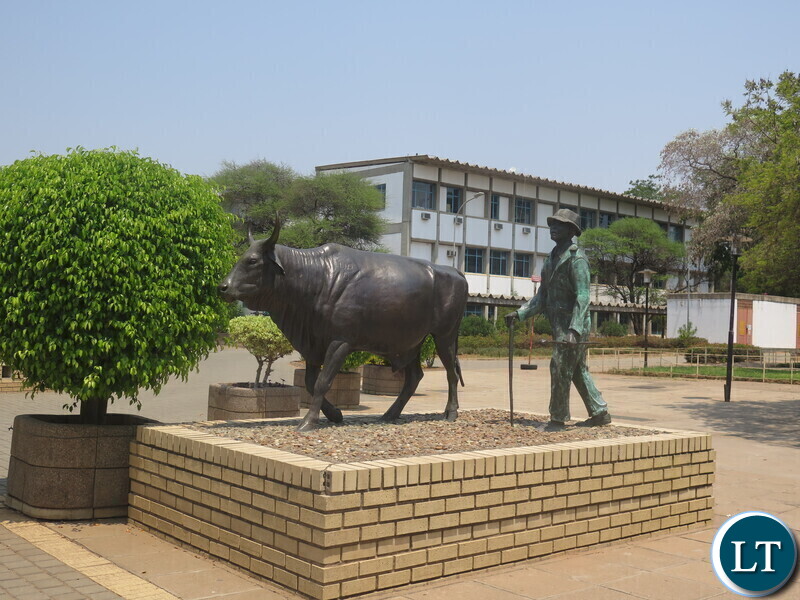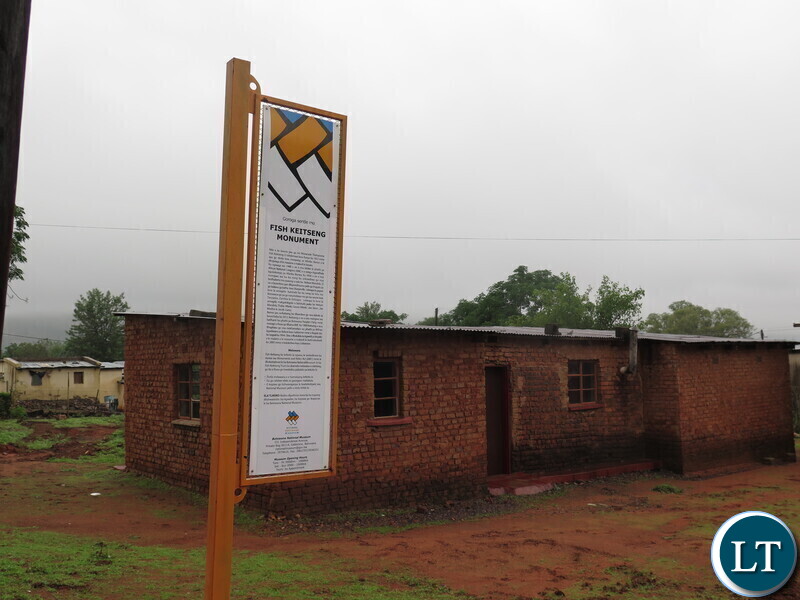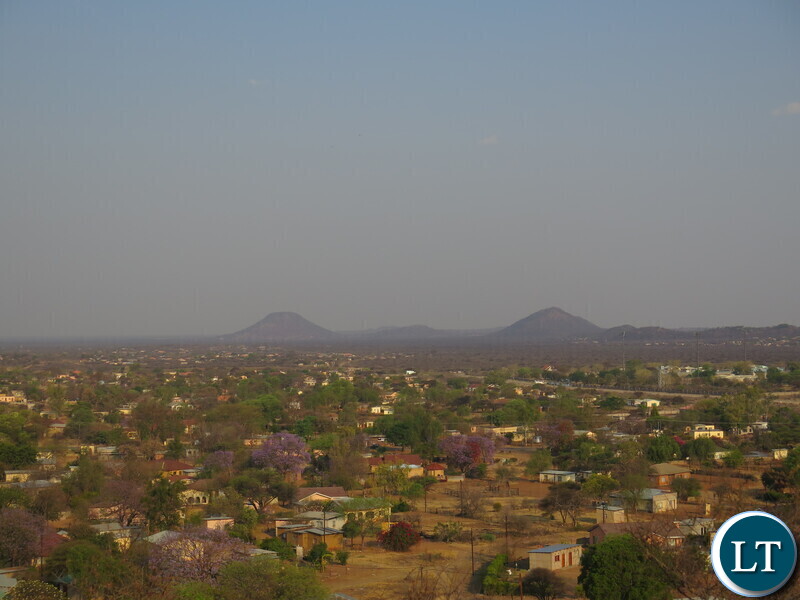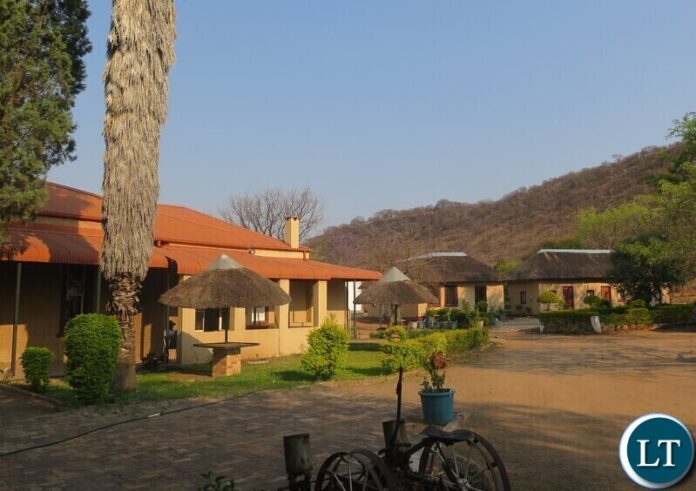By Shoks Mnisi Mzolo
Retracing the footsteps of history and foraging museums in the land of cows, diamonds and wandering elephants.
The 300km journey from Francistown to Serowe, Botswana, is uneventful. The monotony of the terrain is broken, once in a while. Livestock grazing at a distance is visible from here on the A1 national road. We encountered a roadblock before turning right at Palapye: a police officer simply waved the bus driver off soon after exchanging greetings with him, and, along A1, two veterinary checkpoints for foot-and-mouth control.
From A1, I spot railway tracks and Motloutse River. According to archaeologists, Motloutse was a site of gold mining in the 1200s, the age of the Kingdom of Mapungubwe and Great Zimbabwe – two of Southern Africa’s ancient states. Centuries later, in 1971, Botswana’s first diamond mine, Orapa, began its life. Jwaneng, another gem, was to become the world’s richest diamond mine by value. More on the precious stone later.

Botswana is renowned for its wildlife aplenty: buffalo, elephant, leopard, lion and rhino – or the Big Five – as well as giraffe, hippo, impala, jackal, kudu, lechwe, monkeys all the way to zebra, the national animal. Bird safari is as significant. Tourism is booming. An astonishing 12 per cent of the US$20.35-billion GDP is from tourism, which accounts for a tenth of the job market. At nearly 12,000 km² and home to north of 100,000 elephants, Chobe, a national park on the banks of the Zambezi, is larger than Jamaica and equals Nigeria’s Osun State. Botswana’s west is home to the expansive Central Kalahari, spanning 52,800 km², in the league of Bosnia and Herzegovina and, closer to home, equivalent to Burundi and Rwanda combined.
Nevertheless, cattle are the only four-legged beasts claiming the horizon this side of Botswana. However, there was a time when sights of wildlife were familiar. For one, Nelson Mandela and Max Mlonyeni, his comrade, felt they “were on safari” when smuggled to Botswana in January 1962. They saw “all manner of animals, including a battalion of baboons,” recalled Mandela, or, in those years, David Motsamayi – his nom de guerre. Mandela noted that they had even seen a lion.
As an activist, Mandela had travelled to Botswana en route to Algeria for military training. From the 1960s, these lands, now home to 2.5 million people, was an oasis for freedom in a repressed region.

Mandela had travelled here en route to Algeria for military training. decades, Botswana was an oasis for freedom in a repressed Southern Africa: Hage Geingob, Thabo Mbeki, Jacob Zuma, Samora Machel and other freedom fighters transited to exile in Zambia, Tanzania and beyond through these lands. But, in no time the apartheid killing machinery was pursuing activists across the Limpopo. The first known victim of cross-border terror was exiled ex-student leader and teacher Onkgopotse Tiro, assassinated by Pretoria’s parcel bomb on 1 February 1974 in Gaborone. Weeks later, it was John Dube in Lusaka. A year later the Rhodesian regime assassinated Herbert Chitepo in Lusaka.
Back in Botswana, a house that was a shelter to Machel in Lobatse is now a museum. Nearby is the Fish Keitseng home that Zuma, Mbeki and Mandela occupied. Up in Algeria is a new Nelson Mandela Stadium that cost a cool € 300 million. Dedicated to Madiba, the 40,000-seater stadium was officially inaugurated by President Abdelmadjid Tebboune in January 2023.
Journey to Serowe
Back to my destination, Serowe, a Central Botswana village founded in 1902 by King Khama III. In the 1990s, Serowe was among sites cited by Unesco as possible examples of living heritage. Nothing came of that, but such a mention underscores historical richness.
Thataganyana Hill and Khama’s home, now a museum, are must-sees for anyone keen on the story of the charming village and its people and the country’s march from disparate polities into the nation it is today.
While Botswana was a portal to decolonisation for Southern Africa, my reason is to track the rhymes of the past few centuries and ancient history. My previous stop, Khami Ruins – though just 200 km from Francistown, my temporary base – took me back when those lands were home to an ancient civilisation.
As any villager will proudly note, Serowe is home to three of Botswana’s ex-presidents. Teacher-journalist-novelist Bessie Head, one of the region’s literary giants, settled here after fleeing apartheid in her native SA in March 1964. Further, it was in her new country that her literary career was birthed and bred, and where many of her works are set.
My thoughts return to some of Ms Head’s books as our bus advances in a southerly direction. Meanwhile, mercury climbs northwards to breach 30°C before 10 am on a Thursday in October.
Short green-brown trees claim the frame once in a while. The land is mostly flat and dry. Shashe River, which hems Botswana and Zimbabwe before emptying into an arc-shaped Limpopo, is dry in parts. On that note, the sight of cattle is a tribute to Batswana’s ancient and modern water-gathering techniques.
Semi-desert conditions aside, the trip is meditative. My emotion is that of going on a blind date. As I later learned, the history-rich village is clean, slow, crowded and likeable.
Khama III Memorial Museum

Upon arrival, I met Gase Kediseng and Kabo Jone (pronounced Johnny) at the Khama III Memorial Museum. Both are vested in Botswana’s centuries-long journey from pre-unification. Associate curator Kediseng, with facts and trivia on the tip of her tongue, joined the museum 25 years ago. Jone, an ex-school teacher from Serowe and my guide for today, has been here since 2010.
The single-storey museum was home to King Khama and Queen Semane’s, and their children, including Sekgoma II (his son and successor). It chronicles the story of Khama who led his Bangwato community from a dry Palapye. The latter was Khama’s capital from 1889 to 1902. Old records show that the Zuid-Afrikaansche Republiek (ZAR), one of the colonial polities that made up modern-day SA, pursued Palapye in 1899. As he assembled his soldiers, the king warned ZAR’s Boer fighters of the danger they courted if they dared set foot in Botswana “and among my cattle-posts.” The importance of cattle endures amid ever-worsening water security.
Though set to defend their lands against belligerents, Botswana opened their doors to those who sought safety. That is how Bessie Head wound up here. During her stay in Palapye, where she sojourned as a typist, the New Statesmen published one of her works, A Woman from America.
Unbeknownst to her, she had begun the walk to the global stage. Accolades and recognition followed until the author died in 1986 (aged 48) and posthumously.
It was in 2003 that she was awarded SA’s Order of Ikhamanga – a presidential award for excellence in arts, culture, literature, music, journalism or sport. Head is survived by a list of literary works appearing in many languages (from English to Japanese and Swedish). Further, the 1990s saw the publishing of her works like A Woman Alone: Autobiographical Writings.
Head worked as a journalist in Cape Town and Johannesburg as a teacher in Durban and Serowe. The latter vaguely resembles Dilepe, a fictitious village in her Maru – a story of bigotry and love set in Botswana. While similarities between the author and Margaret Cadmore, a teacher in Maru, are apparent, Head’s reality can be detected in Makhaya, a political-activist protagonist in When Rain Clouds Gather – her debut novel, published 55 years ago. In real life, Bessie Head faced über prejudice, a recurring theme in her works. She endured prejudice from a young age because of her parentage. The museum in Serowe is a repository of the author’s papers and preservation of her story. On her desk are different effects, not least two main but humble assets: a typewriter and a kerosene lamp.
Although their oeuvres are not similar, Head’s work brings to mind Buchi Emecheta. It must be the underlying and essential tone of women’s hardship. They both transcended their sufferings to be counted among the finest.
In the main section of the museum, black-and-white and coloured photos, with the aid of an insightful guide, bring to life Seretse Khama – the future first president and scion of the monarch.
It also takes visitors to the era of the trials and tribulations his family endured, as told by Michael Dutfield in A Marriage of Inconvenience: The Persecution of Ruth and Seretse Khama. Jone explains how Pretoria and London conspired to persecute the man for his “crime”: marrying Ruth Williams.
As regent-king, Seretse’s uncle, Tshekedi Khama, also got a taste of racism. British admiral Edward Evans “ordered 200 marines, fully armed” on a 1,800 km journey from Cape Town to Serowe, noted Dutfield. Here, Tshekedi was publicly axed for “exceeding his authority by punishing a white man”.
Politics and economics
Next is a photo of the nation’s first all-male Cabinet. “Only 11 people,” Jone remarks. “Look around to see what they achieved.” I do so and concur. But there are a lot of other things that have gone wrong. I later discovered that while the country’s GDP per capita is among Africa’s highest, the Cabinet has grown disproportionally, and the number of people languishing in poverty hovers at 15%. Botswana is sparsely populated and has had a legitimate, stable political setup since 1966. Coupled with falling life expectancy (from 67 years to 61 last decade versus Mauritius (range-bound at 74-75), poverty levels are an indictment. Head would have gasped at the number of people still “attached to hunger struggles ’til sunrise”. Mokgweetsi Masisi, Botswana’s fifth president, has tinkered at the edges of the problem since he took over in 2018. School dropout rates are rife. Iffy prospects lurk. Factors like poverty are blamed for dropouts.
Back to the beginning of my visit, a British researcher – with Caribbean and African roots – is sifting through some old papers as part of the museum’s digitisation project.
At this point, Jone leads me to a plain pink-and-white room used for community events. Then it’s off to a room with woven baskets of all sizes.
Switching to politics and economics, Jone, flashing a knowing smile, reminds me that diamonds were discovered here in the post-colonial era. “God hid our mineral resources [from Britain],” he says, singling imperialist Cecil Rhodes, whose legacy of dispossession and looting continues to haunt the 21st century. To Britain’s question of how the African country would survive without mineral resources, ruling classes pointed to hoofed assets.
“They said, ‘We have cattle, and that is how we’ve survived for generations. We’ll keep surviving’,” Jone notes. The importance of such assets is underscored by the fund-raising campaign in the 1970s to build the campus of the University of Botswana – the country’s first. The clarion call was “Motho le motho, kgomo” (“One person, one beast”).
It underscores the role of the beast among the building blocks. “It was only after independence that we discovered diamonds,” explains Jone before he taps the province of imagination. “What would have happened if the diamond was discovered while Rhodes and his company (still) ran the show?” Distributing wealth to lower levels has been slow, leaving the door wide open for social ills such as substance abuse, teenage pregnancy and so on.

Jone explains that Rhodes’ open aggression and looting prompted Khama, Bathoen and Sebele – monarchs of neighbouring Setwana-speaking polities – to meet Victoria II in 1895 to get her to “protect” their lands from grabbers. The trio had learned from Lesotho’s Moshoeshoe I, who sued for peace in 1852 after defeating the Brits for the second time in 20 months. Fast forward to the 1890s, colonial land grabs ruled. So did the subjugation and demolition of African states by the Anglo, the Belgians, the Dutch, the French, the Germans and their southern cousins. The death of King Lobengula ka-Mzilikazi in the mid-1890s opened doors to colonialism for Zimbabwe. Cecil Rhodes’ deceit of King Lewanika heralded was instructive. To the west, Germany unleashed “collective punishment”, on Namibians for resisting slavery. Last year’s release of Measure of Men returns us to that era.
The south of the Limpopo didn’t escape slavery either. Botlhale Tema’s People of Welgeval tells tales of serfdom and human smuggling. The story of slavery that bled Congo requires a library of its own — two decades of Belgium’s Leopold II era of atrocities claimed millions of lives.
So, by all accounts, the Botswana leaders had very few options. “This was a big deal for the chiefs. They wanted to go [to London] on their own,” Jone says of the 1895 voyage. “They fastened their shoes and set off, saying only: ‘Maybe we’ll come back alive, maybe not’.” It was a troubled period.
Although Botswana’s desert-like climate has worsened today, bovines outnumber their two-legged cousins. The museum’s Kediseng later explores how people accessed water to sustain livestock. Migration was another way. It was in Serowe, an area they named after a water-rich plant, that they found water. On the museum’s premises stands a borehole which, a century later, still provides water for the property.
Five hours after my arrival, I surrender to the present. Traffic is building up, and the temperature is cooling down. Newspapers speak of heated national politics. The opposition is fraught, the ruling party torn.
While atop Thataganyana, I spotted the famous Mma-Swaneng and Rra-Swaneng hills, standing side by side (like Rra and Mma), and the world-famous village. Up there, stillness is palpable.
© Shoks Mnisi Mzolo


